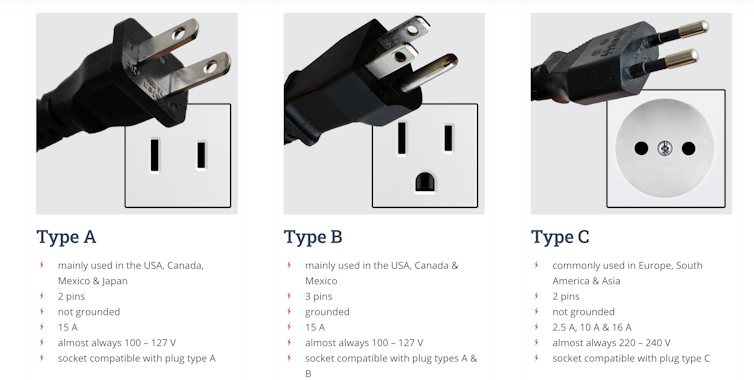Theodore J. Kury, University of Florida

Curious Kids is a series for children of all ages. If you have a question you’d like an expert to answer, send it to curiouskidsus@theconversation.com.
Why do different countries have different electric outlet plugs? – Evie H., age 9, Seattle, Washington
You find yourself in an airport or hotel room in another country, and you really need to charge your phone, camera or game system. But what is that strange-looking outlet? It has round holes! And there are two? Or three? What’s going on here? Why doesn’t this country use the same plugs that I use back home?
The short answer is that the systems that deliver electricity to homes around the world have been built by thousands of people over the last 140 years. And they’re not finished yet. Around the world, about 750 million people – one out of every 10 – still don’t have access to electricity. But for the 90% who do, there are 15 different types of domestic electrical outlet plugs in use around the globe.

To understand why electric outlets aren’t all the same, you need to know how a plug works. In the U.S., the slot on the right side of an electrical outlet is called the “hot” side and the slot on the left is “neutral.” When you plug in a lamp and turn it on, it completes a circuit that allows electric current to flow and light the lamp. The current flows from the “hot” side through the lamp and back to the “neutral” side.
The third opening in the middle of the outlet is called the “ground.” It helps to keep you safe from electric shock if something goes wrong with the plug, or if a wire gets loose in whatever you’ve plugged in. This feature is called grounding, because if electric current escapes from the wires that normally carry it, a special set of wires leads it from the center opening to a rod buried deep in the ground.
To push current through the wires, electrical systems create a pressure called voltage. The higher the voltage, the higher the pressure. You can think of it like running water: It might be a trickle, or a stream, or a flow so fast it can knock you off your feet.
Building the power grid
When inventors like Thomas Edison, George Westinghouse and Nikola Tesla built the world’s first modern transmission grid in the U.S. in the 1880s, the voltage delivered to homes was established at 110 volts. Most of the things that ran on electricity back then – mainly lights – worked best at 110 volts. This is still the standard in the U.S., even though actual voltages on our system tend to run a bit higher.
But when people started to build power grids in other countries, they tried to make improvements. Companies in Europe realized that supplying power at 220 volts instead of 110 volts would be cheaper. At a higher voltage, electric companies can deliver the same power with less current – picture a narrow stream flowing quickly compared to a wider stream flowing slowly. And less current allows for thinner wires. Since the copper that’s used for electric wires is expensive, higher voltage could save money.
Round pins were another early innovation in plugs. People thought they made the plug fit more securely in the socket.
At first, plugs in the U.S. had only two tabs without a ground pin. Engineers developed the idea of a ground pin to make plugs safer in the 1920s. Many countries adopted these grounded plugs immediately, but they didn’t always make them the rule. For example, while the U.S. used these plugs for some appliances, they didn’t become the standard in homes until 1971.
So because different countries adopted innovations like these at different times, the plugs that they used changed throughout the years.
Now that most homes in the world have access to electricity, adopting one global standard would be more convenient than having different types of plugs. But it would require countries that don’t already use that standard to spend billions of dollars to change their outlets, the way they build buildings and even the way they manufacture certain appliances. Not surprisingly, these countries would rather spend that money on something else.
The bottom line is that countries might support the idea of a global standard, but no one wants to change theirs. So for the foreseeable future, if you’re getting ready for a trip, don’t forget to pack your adapters.
Hello, curious kids! Do you have a question you’d like an expert to answer? Ask an adult to send your question to CuriousKidsUS@theconversation.com. Please tell us your name, age and the city where you live.
And since curiosity has no age limit – adults, let us know what you’re wondering, too. We won’t be able to answer every question, but we will do our best.
Theodore J. Kury, Director of Energy Studies, University of Florida
This article is republished from The Conversation under a Creative Commons license. Read the original article.



















